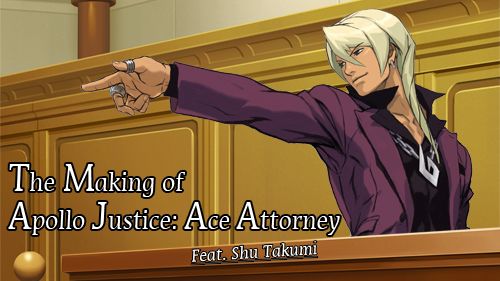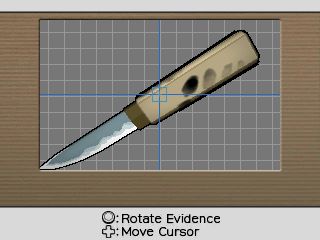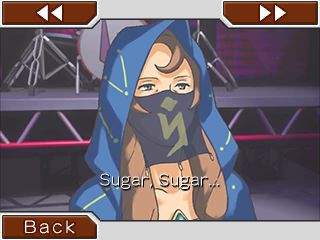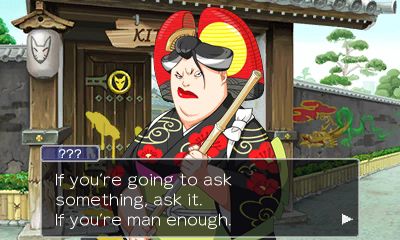
The Making of Apollo Justice: Ace Attorney, Feat. Shu Takumi
Nov 18, 2017 // Janet Hsu
Welcome to another weekend, and another blog! As you can tell by the title, we were indeed fortunate enough to snatch up some of Mr. Shu Takumi’s time for this week’s look back at the making of “Apollo Justice: Ace Attorney”, so let’s get right into it, shall we?
Janet: Hi, Takumi-san. I know it was ten years ago, but I hope you won’t mind me asking you a few questions about the making of Apollo Justice: Ace Attorney …?
Takumi: Sure, I’ve got a little bit of free time now, if that’s alright.
Janet: Great, thanks! Now, as far as I’m aware, AJ:AA was the first game in the series to use polygon models to create video cutscenes.
Takumi: Actually, the first time was for the security footage in “Rise from the Ashes” (RftA) — the one with Meekins and the Blue Badger . (Note: the first three games were originally released for the Game Boy Advance in Japan. The fifth episode of the first game was an extra case the team created specifically for the Nintendo DS release of the first game, or Phoenix Wright: Ace Attorney to us in the West.)
Janet: Oh, I had always thought that was hand-drawn!
Takumi: No, that was really the first time we created and used polygon model videos in the series. Back in 2004 when Nintendo first revealed the Nintendo DS, we had a chance to attend a presentation about the new hardware before it went on sale. I was working on “RftA” at the time, and when I saw the Nintendo DS’s gameplay demo, a number of ideas came to mind, such as forensics testing like a fingerprinting mini-game utilizing the mic. In addition, because of the relatively larger amount of memory available on the Nintendo DS, I remember thinking we simply had to look into how feasible it would be to include videos in our games.
Janet: So it’s fair to say this presentation was a big springboard for “RftA” and AJ:AA?
Takumi: Yes, when I wrote both “RftA” and AJ:AA , the first thing I did was to come up with these sorts of mini-games and then build the mystery and story around them at their cores. Because I made “RftA” and AJ:AA basically one after the other, there are a few areas of overlap gameplay-wise between the two.
Janet: Oh, I was wondering about that, actually. Compared to the first 3 games, “RftA” and AJ:AA featured more hands-on manipulation of the evidence. Was that also because of what you could do with the hardware or was it more something you wanted to do from the beginning and were finally able to implement it?

Takumi: Unlike novels or movies, video games are an interactive medium where the player’s actions drive the story forward, so I had actually wanted to allow players to manipulate the evidence themselves earlier on in the series, and thanks to the Nintendo DS’s more advanced specs, we were finally able to implement it.
Janet: And what about letting players obtain new information from the evidence?
Takumi: I’m pretty sure that was inspired by my experience with the original Resident Evil where I examined a book, and a coin — I think it was a coin? — popped out.
Janet: Wow, that’s one heck of an impression it must’ve left on you, then! But returning to the question of the videos, even though AJ:AA wasn’t the first to include video cutscenes, I was wondering if there was something you struggled with when making the game’s video cutscenes? Like for Lamiroir’s song in Episode 3, for example?

Takumi: I’d have to say that the camera work and other presentation elements were the hardest parts of creating that video, and honestly, it was hard simply because I had never done it before. In “RftA”, it was just a bit of security footage, so there wasn’t much to do in terms of presentation or camera work, but for her song, we had to work with some video production experts and use a bit of trial and error to get it to work just right for the game. Another thing we really struggled with was how different the look and feel of the 3D cutscenes were compared to the other more traditional cutscenes in the game that were created by animating flat 2D illustrations, and how to minimize that gap.
Janet: What about the lyrics for the song? That was your first time writing lyrics, right?
Takumi: Well, it was the first set of lyrics I wrote for an in-game song, but I had actually written lyrics for the Steel Samurai theme song way back during the first game.
Janet: Oh! That’s right!
Takumi: I still vividly remember how we got one of the most famous Japanese anime singers, Ichirou Mizuki, to sing the song live at the Ace Attorney 10 th anniversary event. Now that was a performance.
Janet: I am still jealous about that, you know! But I got to hear a recording of it after the fact, so I guess I can’t really stay jealous. Anyway, not to get sidetracked… So I guess it wasn’t your first go at writing lyrics, but was it difficult for you to write ones that lined up with the bigger mystery of the episode?
Takumi: Not really. The melody of the song originally came about while I was just plucking at my guitar at home, and I really liked the melody I was playing, so I decided to use that in the game as is. I then added the lyrics to it, and since by that time I had already decided what I wanted to use the song for, it was a simple matter of writing the words down. I’m actually curious as to how the song turned out in English.
Janet: Well, since it’s part of the story, it isn’t all that different from the Japanese, I assure you, but I guess the rhythm and placement of words were slightly different for grammatical reasons. Speaking of the localization, I remember you mentioned a long time ago that you didn’t really consider the localization when you created the second and third games (Justice For All and Trials and Tribulations) because you had received word that there would be no localizations of those games.
Takumi: That’s right. When I was in the middle of making the first game, I remember thinking to myself “I shouldn’t create any plot points or puzzles based entirely around Japanese-only language tricks, just in case we make an overseas version.” But when we finished making the first game, I remember asking the producer at the time, Mr. Mikami, “So, are we making an overseas version?” to which he replied, “Of course not, no way.” So that’s when I stopped trying to hold back and freely used whatever tricks I wanted when making the second and third games.
Janet: Tell me about it… *shudder*
Takumi: At least we were finally able to start localizing the games with “RftA”. As for AJ:AA , I knew starting from the beginning that we were going to make an overseas version, so you’ll notice I didn’t use any language-based tricks.
Janet: For which I am eternally grateful, but then what about the Japanese elements like the yakuza?

Takumi: I figured everyone knew about yakuza from Takashi Kitano movies and the like.
Janet: Sadly, his movies were still considered relatively small cult hits at the time — especially in America where foreign films weren’t all that popular. But speaking of real life at that time, I guess this is sort of a spoiler but to what degree did the judicial reforms going on in Japan back then influence AJ:AA?
********* Start Spoilers *********
Takumi: Let’s see, the topic of Japan and its adoption of the new “ Lay Judge System ” (钪審員制度 / baishinin seido), which was a long time coming, was on everyone’s mind. When we were making AJ:AA , we had received two orders from above: 1) bring Phoenix back and 2) work the Lay Judge System into the story. That’s why I created the Mason System for the last episode, and included lay judges in the story. As part of the game’s promotion, we also collaborated with the Japanese Ministry of Justice, which was preparing for the official launch of the new system, and gave a presentation of AJ:AA at the ministry’s head office.
********* End Spoilers *********
Janet: Wow, I knew about the “bring Phoenix back” bit, but I never knew you guys presented the game to the government! Speaking of Phoenix, I know you spent many years writing him, but how different was it writing a whole new set of main characters?
Takumi: My thinking on main characters goes like this: the main character is the player, so the character shouldn’t have too strong of a flavor to them. That’s why I didn’t go out of my way to make Phoenix Wright anyone special, or give him any special features — all of his lines are pretty much just what I would say in those situations. And for Maya, I just naturally wrote a character who I thought would be fun to have by your side as a partner character. The two of them live in my head and whenever I would sit down to write the games, it was like I would hear the two of them bantering with each other inside my head. All of this is why it was so hard to write a completely new main character — the most natural parts of me had already all been used up by the Phoenix Wright character. So I tried to take everything about Phoenix and turned them upside-down. With this great turnabout, I came up with Apollo: a character who is aggressive, passionate, and youthful.
Janet: And what about Trucy?
Takumi: Trucy was also the “opposite” of Maya in a sense, though her love of magic comes from my college self, I suppose. I worked hard to get good at stage magic in my university’s magic club.
Janet: You certainly are no slouch at it, that’s for sure. I had the good fortune of seeing you do a new rope trick the other day. That was really something to make the knot completely disappear into thin air like that! And you seem to be into music too, what with your guitar playing. Is that where Klavier got his rocker personality from?
Takumi: Klavier was meant to be something we’d never seen before in the series. The most difficult aspect for me to create in the first three games was always the prosecutor. We had the “genius prosecutor” Miles Edgeworth, the “overly-concerned with how perfect she had to be” Franziska von Karma, and the “suspicious man shrouded in mystery” Godot, so when it came time to create someone different, I had to really search for an answer. One of the common threads that ran through the first three prosecutors was a sense of darkness, which is why I wanted Klavier to be a bright, carefree character in the form of a prosecutor who was also the vocalist of a rock band. But I wanted to give him a “shadow”, and to that end, I give him a brother in the form of Kristoph Gavin.
Janet: Alright, just one last question before I stop bothering you and let you get back to work: Seeing as how this is the 10 th anniversary of AJ:AA , is there anything you’d like to say to the fans?
Takumi: I’m grateful that even though we made this game ten years ago, we can bring this game to you, the overseas fans once again, on a new platform. It’s been so nostalgic to reflect on and talk about how fired up we all were at the time to make a whole new story after the original trilogy. As for me, I’ve been making games nonstop for the past ten years — games like Ghost Trick: Phantom Detective, Professor Layton vs. Phoenix Wright: Ace Attorney, and the Dai Gyakuten Saiban series — but on this occasion, I think I’ll take a break and play Apollo Justice: Ace Attorney once more with all of you.
I hope for your continued support of this series in the years to come.
Janet: Thank you again for all of your time! I can’t wait to see what your next project will be!
—————————————————-
And there you have it! It certainly seems like new technology drove a lot of new innovations, first in “RftA” and then continuing on to AJ:AA . I guess those two projects were like siblings, in a sense.
Join me next week for the last of these blog entries. I’ll have something special for you guys, I promise! In the meantime, I hope you’ll remember to pick up this newly remastered version of Apollo Justice: Ace Attorney on November 21 st in North America, and November 23 rd in Europe!
Until then!
Catch up on previous blog entries here!
-
Brands:Tags:
-

Loading...
Platforms:
